#originally he was just going to be a boss fight before the tarrasque
Explore tagged Tumblr posts
Text

@achonartist So far out of my 3 players:
- One of them knows, 100%. But since he is a good RPer and is also reveling in the joy of keeping secrets, he hasn’t said shit. He is generally trustworthy to not metagame.
- One of them suspects it, and has actually mentioned as such in character:

But doesn’t seem to know either way.
- Completely unsure about the last player. She adores him but hasn’t mentioned any suspicions.
Really, I expected EVERY SINGLE ONE OF THEM to see the scrunky elf stealing their food in a place called The Perish Lands and immediately connect the dots then confront him on it... but instead they fuckin’ reverse uno’d me and went “we want to adopt the shitty dirty hungry elf man.” So that’s what I get for expecting my players to behave like standard adventurers.

They may, literally, lol. While he’s going to have a monster stat block and a boss fight planned, since the players want to actively speak with him first (”break the cycle of violence,” in their words, which is an ongoing theme in the campaign) they’ll be given the opportunity to essentially run a skill/RP encounter with him.
putting the rest of this under the cut because it’s a lot of D&D rambling bullshit
Mechanically I’ll be giving them initiative, and on their turns they’ll be given the option to speak, ask a question, or initiate combat. This is done not only to put the onus of initiating the fight on the players -- but also to give each of them a chance to speak up.
He will have two hidden “stats” -- hatred of others and hatred of self. Hatred of others starts at full; hatred of self starts empty. If the players do nothing to adjust either of these, he engages in what was originally planned for this encounter: he uses a wish spell to summon a super tarrasque and then engage the party in combat as a CR 27 mythic encounter (I’m still working on his stat block lol).
If, however, players utilize skills, RP, or actions (i.e. giving him rations, whatever other weird shit they do I haven’t thought of) they can lower or raise either of these stats. They can lower his hatred of others by, for instance: continuing to feed him throughout the dungeon, or bringing up examples of how they’ve experienced hope and goodness personally. They can increase his hatred of self by: reminding him of who he was and how much he’s degraded, or the actions he’s caused to put himself in this position.
The further they lower his hatred of others, the less likely he’ll summon the tarrasque. The more they raise his hatred of himself, the more likely he doesn’t fight the party. Too much, and he simply utilizes the wish spell into wishing he no longer exists -- the sole way he can break the curse that binds him to the Woods. Since one of his legendary actions is to recast whatever spell he cast on his turn, he can absolutely chain wish together and do both.
This basically gives the following endings:
- Default Ending: the players do not convince him to stand down, nor meaningfully convince him to change his ways. He summons the tarrasque and fights the party.
- Kill Him With Kindness Ending: the players convince him to stand down, but in doing so remind him of how much his life sucks. He uses the wish spell to wish he no longer exists, permanently destroying Twilight Woods and himself.
- I’m Dying, and So Are The Rest Of You Ending: the players do not convince him to stand down, but fully convince him of his own self-loathing. He summons the tarrasque as one final fuck you, then recasts his last spell and wishes he no longer exists.
- I’m Dying, and So Are The Rest Of You Ending Sad Variant: like the above, except the players have been kind to him at every opportunity presented to them. He summons the tarrasque, wishes that after he casts his next spell he’ll cease to exist... then uses his last spell to teleport the players to the safety of their homes before he vanishes forever.
- How Did You Even Get This Ending: The players fully convince him to stand down, but do not bring up enough of his problem spots that cause him to spiral into self-loathing. Neither the tarrasque is summoned nor does the Twilight Lord kill himself. They all get pancakes after.
- How Did You Even Get This Ending, Traitor Route: The players do the above, but also somehow destroy his ability to cast wish (likely breaking the tablet he uses) and fight him anyway, betraying him after talking him down. Combat starts and now an immortal cursed being hates them with every fiber of his being.
- Likelihood of this happening is 0% But I’ll Plan For It Anyway Ending: Instead of attempting to convince him, the party encourages him to fuck shit up or otherwise agrees to work with him. He summons the tarrasque and does not fight the party. Instead they all drink margaritas and watch the world burn together.
Really, like almost everything involving DMing -- I’m gonna make up a hard mechanics system then throw away 70% of it and wing it when it comes time to the actual encounter. But this is showing that I am at least thinking of it.
Even prior to their decision to try to talk to the big bad, the Tarrasque was always going to be the secret ‘final’ boss. It works with the theme of hunger. If my players somehow resolve all of this with no boss fight or violence whatsoever, idk, Strahd’ll show back up and ruin everyone’s happy ending because he’s a dick.
#palidoozy rambles#d&d#originally he was just going to be a boss fight before the tarrasque#but my players want to see if they can resolve it diplomatically#so be it#i'm a sucker for tragic villains
25 notes
·
View notes
Photo
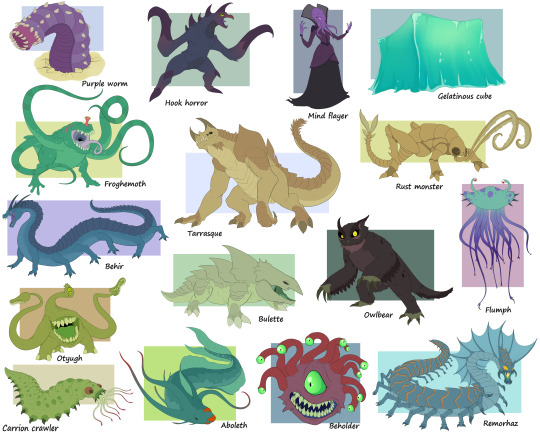
(Casey Here!)
As much D&D as I play, you'd imagine I would eventually get around to illustrating some of their most iconic monsters! Which is to say, the ones that I personally find the most iconic. Which is to say, the ones I memorized when I was reading my dad's monster manual at age nine. Purple worm - Sandworms never go out of style. I've seen a lot of rad designs for this bugger over the editions, but I favor the slightly less reptilian older takes for this particular critter. It's kinda basic, but sometimes that's what you want. It's like a shark or a crocodile: Just flat out unchanged across the ages. Hook horror - I've heard it rumored that Gygax used a small Gigan figure to represent this monster. I can't verify that, but it definitely sounds right. Hook horrors are one of the very first things you meet when you play around in the caves, and they kind of remind me of the Father Deep monsters of the Hork Bajir homeworld that way. Mind flayer - Mind flayers! Basically, take all of your Dracula conventions and dip them in a fresh coat of Lovecraft. There's that old "decadent aristocratic upper caste system who literally eats the poor, but still somehow comes across as less evil than the actual real life 1%" setup that will never stop being relevant. Though personally, I see mind flayers as the first alternative for folks who want to play that monster-who-feels-the-urge-to-eat-their-friends-but-refuses-to-do-it shtick but don't want to deal with vampire baggage. You know, the furry option! ... Slimy? Rubbery? Do we have a word for anthro-cephalopods? I'm only a casual furry. Gelatinous cube - I'm not apologizing for giving this one a slot. Froghemoth - So, back when I participated in my very first long-term campaign, I played a druid. You've met Talia before. Naturally, I was chomping at the bit for the day I finally got to turn her into a froghemoth, and celebrated the day my wish was finally granted and she was allowed to chug human-supremacist-cultists like popcorn. Yeah, okay, the froghemoth is one of the classic vore-monsters. But it's a charming design in its own right. Kind of a freaky Hanna Barbara critter, like you'd see Space Ghost fighting. No matter how many artists draw it, they can never shake that inherent goofiness that third edition tried so hard to purge. I would probably cram them somewhere onto Fronterra if I was sure they were public domain. As is, I'm 99% certain that this is what Visser Three turned into when he ate Elfangor. Tarrasque - D&D's original kaiju! Kind of just takes the name and nothing else when it comes to its mythological origins, but I don't mind. The Tarrasque is that endgame "let's test the players" final boss monster... Or at least it's supposed to be. My DM reskinned it for our final Pathfinder session, and one of the PCs still nearly killed it in a single turn. Also, he let Talia turn into one, so maybe Pathfinder is just bullshit? Regardless, the Tarrasque has one of those simple, iconic designs. I've heard rumors it was based on the concept art for Fallout's deathclaws, and like the Gigan-figure, I can't verify this in any way. With its reptilian features, twin horns, spiny carapace and grabby fingies, it has an undeniable lizardlike quality that I can't help but find charming. Kinda feels like a more refined version of Zilla? Though for an insatiable eating machine, I notice a lot of artists give it very little belly to work with. Come on, this guy eats entire cities! Give him somewhere to put it! Rust monster - An icon of icons, the rust monster! Drawing its origin from a bizarre Chinese "dinosaur" toy, later designs have made it more insectoid in appearance, but never feeling QUITE like anything Earthly. It's the four limbs. Between the four limbs and the tail, it's hard to tell if it's an arthropod mimicking a vertebrate or the other way around. I'm pretty sure this is part of what inspired my ossaderm creatures for Fronterra. Also, Ryla can turn into one in our campaign. I have no shortage of havoc to wreak when the opportunity comes. Behir - Dragons in D&D are kind of... extra. Godlike beings, paragons of whatever personality trait they represent. Whenever there's something uber powerful in D&D, it gets compared to dragons. It makes them kind of unapproachable. Behirs provide all the essentials of a dragon - Serpentine body, scaly skin, horns, sapience, breath weapon, taste for human flesh - wrapped up in a smaller, weirder, IMO cooler package. You know, your Lambton Worms. A lot easier to port in and out of adventures, a lot less of an event when they show up, but still a formidable force in their own right. I like the behir. The behir knows how to taunt me just the right amount. Bulette - Another Chinese "dinosaur" figure monster, the bulette is actually another one I associate with Talia. Whenever we faced a problem that didn't have a glaringly and immediately obvious solution, she would turn into a bulette, whether it was for beating up robots, digging through obstacles, trampling smurfs, navigating labyrinths, distracting slashers with cute dog tricks... it was kind of her signature form. But shenanigans aside, the bulette is just an excellent monster. While the "land shark" shtick may be common, there's a lot more going on with the bulette's design. It's rumored to be a mad wizard's creation, as he combined a snapping turtle with an armadillo and mixed in a helping of demon blood to taste. Personally, I always considered that to be a neat little rumor to flesh out the world, but never assumed it to be true. The bulette just feels too naturalistic for that. Like some kind of protomammal or crocodylomorph, or weird triassic monstrosity. Magic and demons and dragons and so on DO affect the ecosystem. I always figured the bulette was just something that evolved to compete in this new biosphere. Owlbear - This one, on the other hand, I fully believe the "mad wizard was bored" explanation. Another chinasaur critter, the owlbear is frequently made fun of. What makes it scarier than a regular bear? It can't fly, so why have owl parts at all? Why trade fangs for a beak in what is at best a latural move? Well, first of all, fuck you, owls are creepy motherfuckers, and that alone is enough to justify it. But secondly, that's part of its charm. Besides some improved vision, the owl DOESN'T make it more dangerous. What makes the owlbear dangerous is that it's an insane, Frankensteinian monstrosity roaming uncontrolled through the wilderness! It doesn't need weaponry, its sheer temperament is enough to make it a worthy opponent. Sure, the practical threat might not be hugely above that of a bear, but storytelling isn't about numbers. Any asshole can go outside and get eaten by a bear. The owlbear is part of this world. The owlbear is a reminder of what magic can do. Someone somewhere actually made this thing, for whatever reason, and now the world is irrevocably changed because of it. Owlbears go beyond practicality. They bring the lore! Also, bears don't have very good eyesight, so the big owl eyes probably make them better hunters. Flumph - Is that a Japanese-style martian? Do we just have aliens in D&D? Dear lord, I love them! Okay, the flumph has got a sizable hatedom. And that hatedom can eat my ass, because the flumph is precious and perfect just the way it is! Flumphs are designed as a sort of sidekick-type creature. They're not very good fighters, but they bring knowledge and lore to the table. Whether they're aliens from some far off star, seeking your aid to prevent catastrophe, or psionic natives of the Underdark eager to bask in your positivity and hopefully stick it to the tyrants they're forced to share real estate with. My group generally treats them as straight up aliens, benevolent but strange. Course, we're all pretty strange, so we get along just fine. Otyugh - Okay so, the aberration creature type implies that this is something from another world that doesn't belong. And yet otyughs, which are aberrations, are an essential part of this world's ecosystem? Okay, I can buy the idea that an alien organism adapted to our world and is now a key part of it. Fronterra's got a TON of that. It just feels like after a point, the otyugh would be considered a beast? Otyughs are great. Every ecosystem needs a decomposer, and every fantasy story needs at least one dive into the sewers. Otyughs provide both, and are intelligent enough to keep the plot moving if it hits a snag. There's always going to be garbage, refuse, carrion, decay, things that need to be broken down and processed. Carrion crawler - The carrion crawler is pretty similar to the otyugh in that it's technically not considered a beast, and therefor must have its origins elsewhere, but feels so integrated into the ecosystem that it just feels like it belongs. They usually can't talk, so they're not just reskinned otyughs, but I still consider them pretty essential. Otyughs find a singular spot where waste is dumped and shovel it down at their leisure, while carrion crawlers skulk through the tunnels, actively seeking their food. The crawler got one of the most radical redesigns on the transition from second to third edition, but I can't really choose a single favorite. The oldschool tentacle-faced cutworm looks like it could be a real animal, while the googly-eyed Halloween decoration feels like it could be from another world, merely having set up shop here. Could there name apply to two wholly different creatures? If so, then I'm not sure which one mine would be considered. I kinda mashed them together into something that doesn't quite feel like either. But I like it for what it is. Maybe I'll sneak it onto Fronterra. Aboleth - Tentacled, telepathic sea creatures who turn humans into slimy minions, who remember everything their race has ever seen, and who are always plotting something behind the scenes. Yeah, the aboleths really crank up the Lovecraft elements. Actually, between the mind flayers, the flumphs and the aboleths, even the most oldschool D&D covered quite a few essential Lovecraftian bases. The flayers are your corrupt yet still recognizable humanoids who can be considered truly evil, the flumphs are benevolent-yet-bizarre guardians who know more than you, and the aboleths are the truly unknowable, sinister intellects. The fact that they can barely function on land honestly only adds to that, IMO. They're inherently difficult for a party to reach, and they offer some nice underwater adventure seeds. Not enough adventures go underwater. There's this perception that the ocean is bad for storytelling because so many writers lack the creativity to make it work. I wanna run an underwater adventure now. Beholder - Icon of icons! THE D&D monster! The beholder! Paranoid, jumpy, always five steps ahead and twenty steps perpendicular! Beholds are fun in just about every way. Between their wacky, diverse designs, their elaborate lairs, their eccentric personalities, their bizarre powers, you're never gonna run out of fun with beholders. Remorhaz - It's always been a thing that bothered me with environment-based monsters. Why does the ice monster who lives in the cold use ice as a weapon? Aren't most of the things it encounters going to be resistant to the cold? Sure, a cone of cold will still kill a polar bear, but a lot of the monsters in the tundra are outright immune to cold. A while dragon's not going to get much use out of its breath weapon fighting frost worms and frost giants. That's one reason the remorhaz sticks out to be. We have an icy tundra beast whose insides are a scorching furnace, which it can intensify and weaponize as it sees fit. Which also conveniently explains why its design - a sort of cobra-esque centipede - invokes warm-weather creatures, despite its icy environment. It's a nice subversion of the usual tropes, plus it's just a memorable, cool looking critter to begin with. On a smaller note, the remorhaz feels like a good loophole for Ryla's "no cold weather morphs" rule. Turning into something elementally affiliated with ice is no good, but a non-magical monster that survives the cold by superheating its insides? That seems perfectly viable to me!
#RiftWitch#My art#D&D#DND#Dungeons & Dragons#D&D monsters#Purple worm#hook horror#mind flayer#illithid#bulette#froghemoth#tarrasque#rust monster#behir#owlbear#flumph#carrion crawler#aboleth#beholder#remorhaz
92 notes
·
View notes
Text
WILD ARMS 2 - Golgotha Prison
The name is not subtle, but the reference itself is actually oddly superficial. At the end of the dungeon, Ashley is separated briefly from the party and Lilka and Brad are captured and tied to crosses, evoking the characters Dismus and Gestas, the thieves crucified during the same execution as the biblical christ. There is little reference to that actual narrative however, instead seeming to draw from the fact that the name Golgotha is taken to be an epithet to mean literally “A Place of Skulls,” which seems rather appropriate and obvious for an execution field.
Bookending the start and end of this dungeon, we fight the boss monster, Trask. First in a scripted “loss” and then in a solo match with Ashley’s new dark henshin hero form, the “Grotesque Black Knight,” Knightblazer.
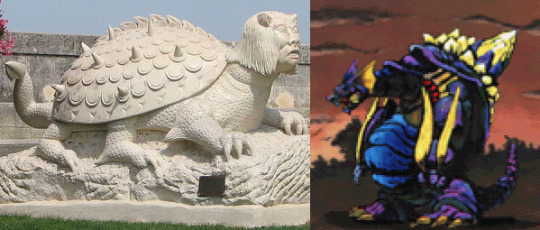
“Trask” is yet another transliteration* issue that comes from the juggling between languages. It actually comes from the Tarrasque, another monster most readily identified from its appearance in the original Dungeons & Dragons Monster Manual, itself originally taken from semi-obscure French myth of Saint Martha of Bethany and the Tarasque of Tarascon.
*(I realize I use this word a lot and it might not be as common use to others. A “translation” lifts meaning between languages; a “transliteration” is to lift written characters between them. Example: “Left” in English translates to 左[the direction] or 残[what remains] but transliterates to レフト. Inversely 左 and 残 both translate back to English as “Left” but transliterate as “hidari” and “zan” respectively; and レフト transliterates back into English as “refuto.”)

Surprisingly, the Wild Arms 2 design (which would also go on to persist as the core design throughout the rest of the Wild Arms series) is based more on the original myth than the D&D representations tend to be: While the end product looks nothing like the depictions of the Tarasque of myth, it retains the spiked turtle shell, the prominent dual horns, poisonous quality, and fins on its head here account for being “half fish.”
Also of note is that the title card identifies it as a “Dragonoid” and it has various metallic and machine-like features. These details are neat because it positions it as being not-quite a dragon, to work around a fact that will pop up much later: That dragons in Filgaia are extinct. And also to play into the fact that Dragons in Wild Arms are semi-mechanical lifeforms.
In any case, our scripted loss to Trask the first time around ends with the team knocked out and imprisoned in what appears to be a disused execution ground and associated holding cells. In our escape we run into monsters fitting the theme, who appear to be natural inhabitants, rather than guards put in place by the Odessa terrorist soldiers who are actually holding us here.
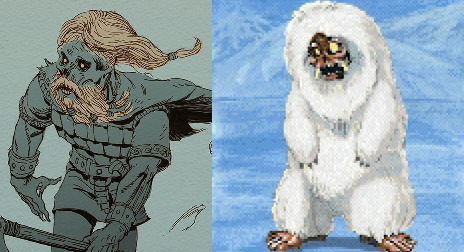
First up is the Wight, a classic undead warrior monster generally taken from D&D, but with a little more behind it than you might expect. The term Wight in English lore actually traces back quite far as an archaic term with little to no real association with monsters. The real intersection with name and subject comes from an early English translation of the Nordic Grettis Saga; In it the zombie-like creatures now better known as Draugr were referred to as apturgangr (lit.”againwalker”) but were translated as Barrow-wight. (lit.”[burial-]mound person”)

This may seem an odd choice, but the translation came at the hands of the eminent bookman William Morris. I say “bookman” because he was not just a prolific author of prose and poetry, but a pioneer of the revival of the British textile and printing industry. He and his wife, Jane Burden, did extensive arts, craft and design work in book and print design, book binding, and wall paper all stemming from the intricate design of modular and tiled printing blocks and stamps. Oh and he translated various works of epic poetry and myth into English, including old Roman epics, French knightly romances, and of course Norse sagas. (all of which he wrote and published what was basically fanfiction of, btw)
His seemingly erroneous “translation” of the Barrow-wight came as an attempt to reflect a comparable agedness to the name: Rather than translating from old Norse into modern English, he chose what he thought a suitable old English equivalent; “Barrow” referring to pre-christian Anglo-Saxon burial mounds, and “Wight” meaning “thing” or “creature” but often used disparagingly to refer to a person. The nuance there is actually quite clever, as the old Wight referred pretty exclusively to those living, even if it didn’t specify by definition, and that uncertainty or contradictory kind of implication uniquely fits a description of the undead.
This term would be picked up by J.R.R. Tolkein for use in Middle-Earth, retaining their lore and function from Norse legend to describe undead warriors. And from there you can follow the usual chain of influence to D&D, where the shortened term Wight really solidified itself as synonymous with the undead, and eventually down to Game of Thrones, where George R.R. Martin cleverly brings the whole thing back around to old risen bodies of northern warriors, not unlike the Draugr of Norse myth.
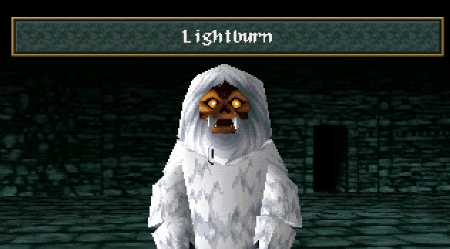
Anyway in Wild Arms 2 we get some sorta death yeti ¯\_(ツ)_/¯
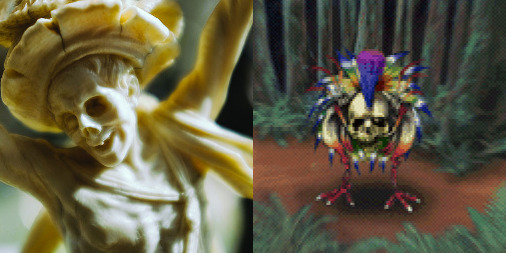
Next up is the Ghoul, which I think we all know is a pretty generic term in modern parlance, but it’s specific origins date back to pre-Islamic Arabia. It entered into English via translations of the original French translation of 1001 Arabian Nights, where it appears in one story as a monster lurking about the cemetery devouring corpses.
The Ghoul identity as a corpse eater quickly broadened into flesh eaters, and the association with lurking about graves in turn marked them as undead themselves until eventually the term became loosely applied to any variety of undead, including the thrall of vampires, supplanting the flesh of the dead with blood of the living and achieving a truly far removed meaning. Even in modern Arabic the term now broadly applies to any number of fantasy monsters.

And so long as we’re dabbling in pop culture transplants; the Arabaian word Ghul is in fact the same used in the name of the Batman villain, R’as al-Ghul, whose name/title has always been erroneously translated as “Head of The Demon.“

I have no idea why it’s a chicken with a mohawk but i love it
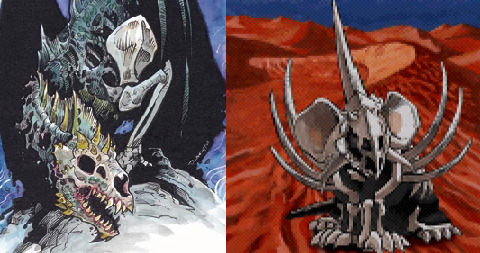
And finally the Bone Drake. I don’t know that this one actually has any real specific lineage...
“Drake” is generally a synonym for dragon, although there is some case of fantasy semantics where different settings will try to define distinct body types of dragons each with their own name, in which case Drakes are often either dragons which simply don’t exceed a certain size (generally no bigger than a non-magical animal such as a dog or a horse) or a wingless variation of whatever the setting’s prototypical dragon might be. I don’t know for certain, but I think this distinction in modern fantasy started with Tolkien’s wingless fire breathing dragon, Glaurung, and its offspring who were referred to as fire-drakes.
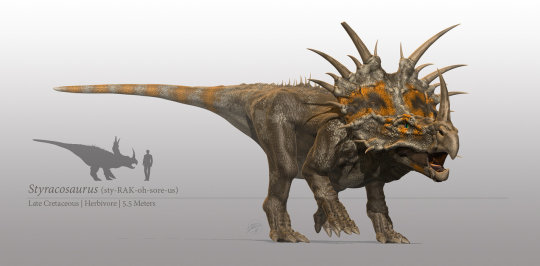
In any case, the specific term “Bone Drake” Doesn’t seem to appear with any visibility prior to Wild Arms 2, which leads me to believe it was just their name for a generic bone dragon-like creature. It does make for an interesting companion, aesthetically, to Trask being here, although there don’t seem to be any implications that Trask lives in this dungeon at all. Other than just being an obvious combination of cool fantasy things, it may also be pulled from Dungeon & Dragons’ Dracolich/Night Dragon; an undead (often skeletal) dragon raised from the dead, often by their own necromantic spells, hence the term “Lich.” For whatever reason they are oddly reminiscent of shield crested dinosaurs like the Triceratops or Styracosaurus.
The attack Rhodon Breath doesn’t tell me anything either. I think it’s just meant as “Rose Breath,” translating the “Rhodon” bit pretty literally, and references the smell of roses being present as a funeral, or else the palor of the faded pink color also called “Rose Breath.” There is some apocryphal reference to a Rhodon but of no significance that I can tell.
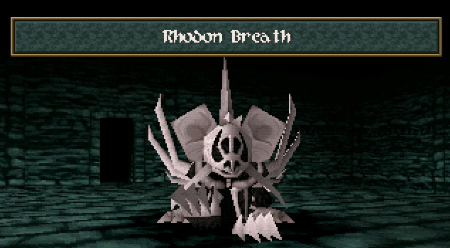
Clearly the theme here is death and the undead, and with some small stretch on part of the Wight, we could even say skulls all befitting Golgotha’s “Place of Skulls” epithet. It’s a really neat way to build this dungeon, albeit a little on the nose. But I really like the idea that the dungeon appears to be abandoned and now haunted by all these reanimated corpses and bones before the villains arrive to use it for their plans. Oddly there isn’t much of a martyrdom theme here, although we’ll get plenty of that a little later once we recruit our second magic user, summoner, christ figure, and perfect beautiful boy, Tim Rhymless to the team...
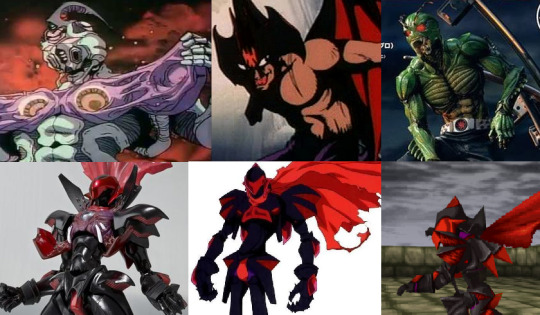
Anyway we get out, we fight Trask for real. Ashley turns into a saturday morning superhero. Trask gets solo’d. And we all just kinda move along without asking too many questions... Although the game dialogue describes this new form as a “grotesque black knight” the sprite work, 3D model, and even original character art don’t really convey much in the way of “grotesque” but in the context of the tokusatsu, henshin hero elements it’s not too hard to imagine that the design was meant to evoke a similar aesthetic to gruesome suit heroes like Guyver, Kamen Rider Shin, and Devilman. I do love the gill/tendon-like organic vent structure in the pauldrons that stay. And although it’s not visible in any of these images, but the D-Arts model has an exposed segment of vertebrae between the shoulders; that along with the teeth(?)/ribs on the open chest panels really helps bring out more of the “grotesque” quality of the design.
16 notes
·
View notes
Photo
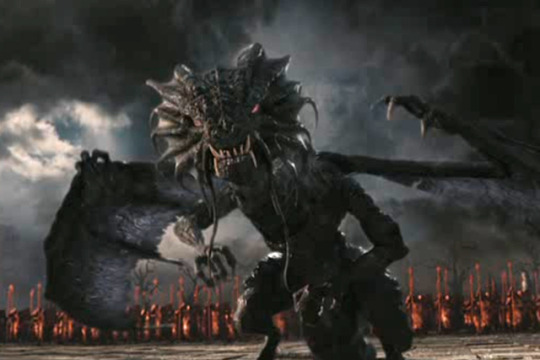




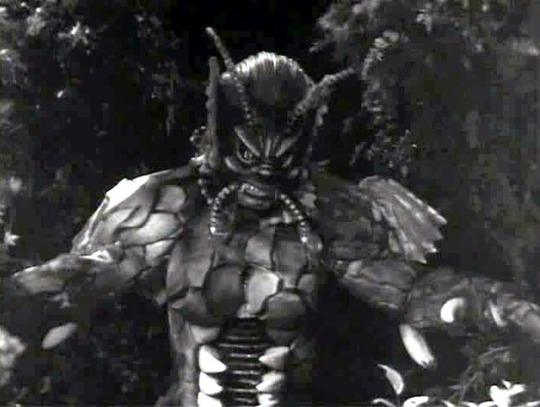


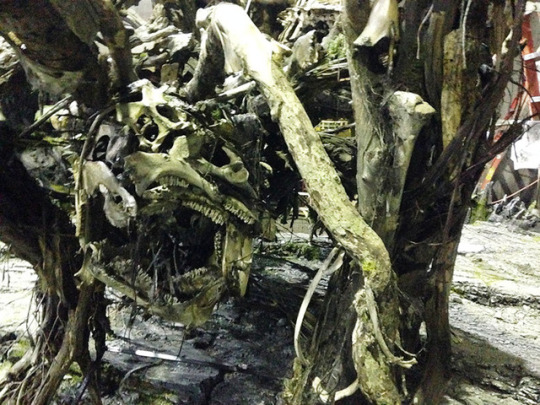
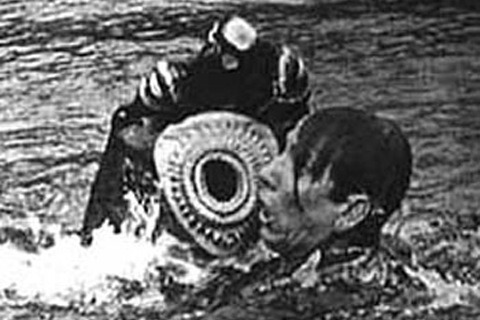
30 Day Monster Challenge 2 - Day #23: Favorite Bad Movie Monster
Alright, so most of these movies aren’t really all that bad; they’re just kind of ‘meh’. But they would have been a lot worse without these cool and/or goofy monsters.
1. Jabberwocky (Alice in Wonderland 2010)
I am prepared to disclose that Tim Burton’s Alice in Wonderland was not horrible, but 60% of that opinion stems from the Jabberwocky. (The remaining 40%is 30% the other monster designs and 10% lesbian subtext.) The Jabberwocky has always been my favorite part of the Alice mythos (surprise surprise), and not to sound petty, but I have dropped Alice movies just for not including the brilling beast. Burton’s Jabberwocky might not be my favorite, but it has a lot going for it. The way they treat it is basically as Wonderland’s Tarrasque; a living WMD, a legendary kaiju, the ur-monster in a world teeming with dangerous and crazy creatures. The way it wakes up is even a direct nod to Chernabog from Fantasia; they are literally equating this thing to the Devil.
Second off; Christopher Lee.
Finally, when the Jabberwocky meets Alice to fight, he says this thing about meeting his ‘old foe’, ‘the vorpal one’, in battle again. It is made explicitly clear that he is talking about the vorpal blade, not Alice. And that just… I don’t want to say that that changes the entire movie, but yeah, it kind of does. The implications here are that the vorpal blade and the Jabberwocky have fought each other countless time before in the past. The history of Wonderland is just the history of a dragon and a magic sword fighting. Is the vorpal blade sentient? How many times have these two fought? This kind of transforms everything about the setting the movie has established for the last hour and a half. It’s just so filled with so much potential to me.
2. Torgo (Manos: The Hands of Fate)
Y’know, when you’re in a dark place, you have to find your own light. A source of motivation, something you can cling to to pull you through to the other side. Maybe that’s a dream, a goal at the end of the tunnel, or maybe it’s a hero, someone you can look up to. I’m not saying that Torgo is a hero, but he inspires me. There are weeks at work where I just don’t want to get out of bed in the morning. I come home at night to an empty room and fall asleep alone. It gets hard, is what I’m saying. But you know who never stopped trying, even though he hated his job and was lonely too?
Torgo. That’s who.
Everyday Torgo gets up, throws on his blazer and hat, and he goes out there and busses a haunted motel for a boss he hates. But he does it, every day. And if Torgo can do it, you can too. So you’ve got to get out there and be the best damn lackey you can. You’ve got put in the work to make it to tomorrow. And when the good times roll in and come shining down on you, you take a minute to remember the man who helped you get here. Take a minute to remember Torgo, looking down on you from Cloud No. 9, shedding a tear.
3. Radu (Seventh Son)
The Last Apprentice series is actually a pretty cool (and grim) series of dark fantasy/horror young adult novels, kind of like junior’s first Solomon Kane. The Seventh Son movie based on the series has piss-all to do with it, and its only redeeming features are some cool monster designs and Jeff Bridges. Of those cool monster designs, the stand-out for me is Radua aka Muslim Dragon Kratos. He’s one of our villain witches chief thugs, and is unnecessarily cool for a side-character. He’s got this whole Nosferatu Zodd code of honor thing, and wields these two chain blades and probably could have been the villain in his own movie.
Now that alone would have been a neat detail, but then he can turn into what I honestly consider one of the more interesting dragons in recent cinema. I talked before about how one archetype of dragons was of being these unholy, scavenger type wilderness monsters, and that’s kind of the vibe I get from Radu’s dragon form. It’s all lanky and feral looking. It has too many limbs, and it walks around like it doesn’t know how. It’s another unnecessarily cool design for such a generic movie, and it’s definitely worth checking out.
4. Krakensaurus (Jack the Giant Slayer)
I don’t want to be mean and discount Jack the Giant Slayer as ‘discount Ray Harryhausen’, but thems is the breaks, as the saying goes. The movie is kind of charming in how earnestly it plays to being a 1960s fantasy movie, with princesses in pink dresses and warlocks with goatees and a rhyming leprechaun. The movies stop-motion monsters don’t really live up to industry standards, though. But I can’t sit here and lie and say that I don’t have a special fondness for the sea monster at the end. The movie’s penultimate scene sees our heroes trying to escape the warlock’s castle, so the villain summons a two-headed giant (or ettin, if you know your monsters) which looks suspiciously like one of Ray Harryhausen’s cyclopes. Trapped in a sea cave, the rhyming leprechaun trapped in a bottle (roll with it) summons a sea monster to deal with the problem.
Sometimes it’s the little things in life, like watching two weird looking monsters fight to the death. Our sea monster is a blue-green mixture of kraken and allosaurus, and I’m pretty sure its toy had more detailing than the actual moving model. When this guy showed up on the screen, six year old me was hype enough to punch through a wall. I spent the next week drawing pictures of him so I wouldn’t forget him. This movie has 100% more sea monsters and singing leprechauns than The Seventh Voyage of Sinbad, and that almost makes up for its deficit skeleton warriors.
5. Queen of the Lair (She Creature 2001)
Stan Winston was on the helm for this little lady’s monster design, and it shows. A mermaid queen, it’s hard to tell if her monster form is her real shape or just something she can morph into. Even her basic mermaid form is pretty interesting; the split tails remind me of sirens or tritons. Her monster shape, though, is pure Stan Winston gold. There’s more than a little bit of the xenomorph queen in there, between the crest and the fangs. Someone threw it into a blender with a sea serpent and a viper fish and what comes out is the most badass mermaid to ever slink across cinema. She rips people’s heads off, her tail is covered with bone spikes, and she can sing a siren song to summon up her mermaid swarm. Oh, and psychic impregnation powers. That part’s kind of important.
6. She Creature (She Creature 1956)
Aforementioned sea monster queen was part of a series of horror films based on old b-movies, so this is the original She Creature. Even today, this is one of my favorite designs from the 1950s. Paul Blaisdell might just be the king of B-movie monster suits, and belongs up there with Ray Harryhausen in the great monster hall of fame. The she creature looks like the sum product of an orc, a lobster, and a scorpionfish. It’s a shame you only see her in monochrome, because her color scheme is a startling mix of green and pink. What I find most fascinating is the concept that this is supposed to represent some parallel evolutionary stage of humanity. This is supposed to be a different version of Homo sapiens that never left the sea. Stan Winston’s mermaid queen is great, but I would still love to see an updated and more articulate version of this design.
7. Vampire Spawn (Van Helsing)
This raises so many questions. So the crux of Van Helsing is that Dracula needs Frankenstein’s monster to power a force-field that will allow his swarms of vampire spawn to survive past infancy. I bet you thought vampires reproduced by biting people, right? Well, apparently they also have egg-sacs. Just, massive, Aliens style egg-sacs full of bat/human fetus monsters hungry for blood. It’s so stupid that I love it. These things are horrible and adorable; they remind me of chupacabras. I want one as a familiar, or at least statted up for a tabletop roleplaying game. Just really try to avoid thinking about the whole egg-sacs thing and all the implications that brings to vampire mythology.
8. Emperor Tyrannus (Attack of the Super Monsters)
I don’t… I don’t think I have the strength to really get into Attack of the Super Monsters. When I watched it, liquor was involved. Describing it reads like a parody of Japanese media that involves anime, men in monster suits, and giant robots meant to sell collectible toys. But it’s real, and the realest shit ever is Emperor Tyrannus. Emperor Tyrannus is literally a giant tyrannosaurus rex who is the evil mastermind of an underground civilization of dinosaurs. The dinosaurs talk, because shut up, and Emperor Tyrannus in particular talks with a villain voice that I just can’t really convey through text. I think the closest I can get is saying that he sounds like someone doing an imitation of Brian Blessed while having a stroke. Emperor Tyrannus shoots laser beams from his eyes that mind control the other dinosaurs into being evil, and watches them fight a hermaphroditic cyborg superhero in a drill/airplane. Look, you need to see this for yourself. I’m not doing this justice. Get your friends, find the DVD, and strap in for a wild ride.
9. Witch Tree (The Last Witch Hunter)
The Last Witch Hunter is another guilty pleasure move where Vin Diesel brings what I’m pretty sure is one of his D&D characters to a movie and somehow ropes Michael Cain and Elijah Wood into it with him. Our villains are, in a surprising twist, witches that cook up some fairly grotesque magic. One of the creatures meant to act as the witches’ guardians is a magical sentinel, and it just goes so hard and so dark for what amounts to a stick golem. It’s the fine details that make this construct stand out. The extra limbs let it move faster and have extra attacks, the jawbones around the front form a crude mouth, and the branch rib-cage makes it look like something that used to be alive instead of something that was just magically summoned. There’s so much work poured into this one monster, and it’s definitely a treat to see it at the end of the movie. Rethink your golems, kids; treat yourself better.
10. Giant Leeches (Attack of the Giant Leeches)
I used to be pretty intensely leech-phobic when I was younger (and by younger, I mean a couple of years ago), but even then I knew the giant leeches were lame. Incredibly lame. Like, honestly kind of pathetic. I kind of like them out of a bizarre sense of pity. Giant leeches should scare me, but these guys are just goofy. A leech isn’t a hard design; it’s a tube with a sucker on each end. But I am almost convinced that the person who designed these monsters had never actually seen a leech, or possibly even a worm. But the movie still treats them with all the dignity and awe of the Creature of the Black Lagoon. There are prolonged sequences of these guys swimming underwater, floating around like hungry garbage bags. These things are not, nor were they ever, leeches; they are some kind of aquatic octopus or confused anemone. That’s why they need our love, our protection; because they’re too stupid to survive by themselves.
#30 Day Monster Challenge 2#30 Day Monster Challenge#monsters#movies#fantasy#mst3k#stan winston#paul blaisdell#long post
28 notes
·
View notes
Text
What to Learn From Every RPG Campaign I’ve GMed* or Played In
(All campaigns that lasted more than three sessions that I’ve ever played in, in chronological order; marked by a * were me as GM. All others were me as player.)
Denver Arcana (0*) (d20 Modern, Urban Arcana, Extensive Supplements and Homebrew, Kitchen Sink Urban Fantasy)
LESSON FOR THE GM: Self-insert PCs are perfectly doable, but don’t include other real-life people as NPCs. Especially if any PC IRL has a thing for any of the NPCs. Double-especially if the GM kinda does too.
Clyde Lake (d20 Modern, pure, contemporary horror)
LESSON FOR THE GM: Before launching a horror game, have a pretty good idea what the source of the horror actually is.
Plaguelands (D&D 3.5e, classic fantasy with Oriental Adventures influences)
LESSON FOR THE GM: If you get a guy who ALWAYS TAKES THE BAIT, knowingly and gladly, great! Just…have a plan for when he takes the bait. A plan that lets the campaign keep going, maybe?
LESSON FOR THE PLAYER: When using illusions to persuade people, consider the audience. Maybe consider very carefully whether your choice of illusion, while persuasive to your target, might also cause a wave of panic and mass suicide.
d20 Tropico* (d20 Modern, pure, action-adventure)
LESSON FOR THE GM: A little more research is needed for setting a campaign in a war-torn Caribbean island nation than just…playing Tropico.
LESSON FOR THE PLAYER: If you play an INT 5 bruiser and the campaign is not 100% combat, you’re going to be locked out of a lot of playing.
Thaumapunk* (d20 Modern, Extensive supplements and homebrew, kitchen sink sci-fi/magitech)
LESSON FOR MY PLAYERS: I am not afraid to TPK your asses.
LESSON FOR THE GM: A bad ending goes down so much smoother with a hastily-written sequel hook in the epilogue that makes the players think that at least everything they did didn’t amount to a complete waste of time.
Apocalypse Arcana* (D&D 3,5e, mostly official supplements, post-apocalyptic North America fantasy)
LESSON FOR THE GM: It’s okay to fudge things if you misestimate an encounter. But consider being more subtle than having all the henchdemons announce that it’s time for their union-mandated lunch break and quit the field, leaving only their boss to fight the party.
LESSON FOR EVERYONE: If someone accidentally plays a furry when they’re vehemently not a furry, never, ever, let them live it down. (Real actual furries get a pass in my book; y’all do you.)
Denver Arcana (I, II, III) (d20 Modern, Urban Arcana, few supplements, kitchen sink urban fantasy)
LESSON FOR THE PLAYER: Characters really are fun when they’re actually characters, not just self-inserts or piles of stats for launching fireballs! Make sure the campaign is going to last before commissioning artwork of them, though. Or else you’ll wonder if you’ve got your money’s worth.
LESSON FOR THE GM: If you continually reboot a campaign at low levels because you don’t know how to cope with your PCs once they reach high levels – don’t be surprised if they start finding level-independent ways to fuck with your shit.
Thaumapunk X* (d20 Modern, extensive supplements, a bit less homebrew, better-thought-out kitchen sink sci-fi/magitech)
LESSON FOR THE PLAYER: If the GM interrupts your convoluted attempts at planning with an alien invasion, that means he disapproved of something. Possibly that you were taking two hours to plan something unimportant.
LESSON FOR THE GM: It’s okay if the players know who the final boss is in advance (because he’s the guy who TPKed them last time), but they’ll understand if his stats aren’t identical to what they were centuries before. They’ll accept the change if it means you don’t feel compelled to spring the final boss on them 75% of the way through the apparent story because you realized that it wouldn’t be a challenge for their over-optimized builds if things ran their course.
Strangeworld (D&D 3.5e, mostly official supplements, weird primal-feeling fantasy that turned out to have huge space-fantasy elements just out of view for most of the game)
LESSON FOR THE GM: What would be awesome in twenty or thirty sessions will be a soul-sucking mess if it takes eighty.
Diaspora* (D&D 3.5e, mostly official supplements, rapidly escalating to fight mythological-class threats and thwart a multi-pantheon plot to unmake the world, which somehow entailed overthrowing a powerful dwarven nation to build a giant-ass steampunk cannon to launch yourself to the moon so you could fight the Chariot of All Evil before it could bring its terrible power too close to the world’s many doomsday cults)
LESSON FOR THE GM: If there’s a chance that one player will realize that he doesn’t like the epilogue that he’s on track for, give him a heads up in advance. So you’re not re-writing the ending at very moment that the ending is happening.
LESSON FOR THE PLAYER: If you gaining demigod status as your retirement plan depends on the cooperation of the rest of the party, clear everything with them 100% first. Explain any possible hang-ups to the satisfaction of the Paladin before the moment of truth.
Braveworld (D&D 3.5e, mostly official supplements, standard medieval western fantasy)
LESSON FOR THE GM: Players say they just want a normal campaign as a breather after a crazy one, but they lie. Boredom sets in fast, and that deprives you of the critical enthusiasm needed to overcome repeated scheduling problems or player conflicts.
Magnum Opus* (d20 Modern, massive supplements, a crossover involving every previous campaign on this list and others that never got off the drawing board, starting with the PCs on their first day of high school and culminating in them saving literally every universe)
LESSON FOR THE GM: You get to push a system to its maximum extent until it pretty much burns out everyone’s desire to play it because there’s nothing else to accomplish, once. Make it worth it!
OTHER LESSON FOR THE GM: If you set plot-critical rolls with a difficulty so high that they’re mathematically unachievable without extra measures, remember to hint at those other measures to the player in question. He might not be firing on all cylinders tonight and if he gets literally every party member killed (even if temporarily) because as far as he could tell you wanted him to roll a 22 on a 20-sided dice, you’re getting the blame for that.
OTHER, OTHER LESSON FOR THE GM: No player ever needs a ring of three wishes. Not even with a single wish left on it. If there’s any charges left on that sucker it will fuck up your epilogue right good.
Omoikane (D&D 3.5e, very Oriental-Adventures-themed, lots of demigod-tier enemies running around)
LESSON FOR THE GM: If a player seems to fundamentally misunderstand how a rule works, and seems to have built his character around that misunderstanding, correct him early. At a critical moment when he’s trying to save the entire party based on a heroic effort he thinks the rules let him do is a bit too late.
LESSON FOR THE PLAYERS: If the way you play a character is so effective that future GMs ban the entire class for the rest of time, you’ve mostly cheated yourself out of something cool.
The Low Road (D&D 3.5e, standard medieval western fantasy but the PCs are evil and in pursuit of cosmic power; culminating in one character [uh, mine] becoming the replacement source of all evil in the world after his original plan fell through due to his god not existing)
LESSON FOR THE GM: “An Evil campaign” means different things to different players. You’re not going to get a consistent vision of how to proceed with an evil scheme if your only criteria is “make an evil PC”.
LESSON FOR THE PLAYERS: Evil cultist PCs planning to betray their parties at the last moment to further their eldritch-horror-patron’s plans should probably first verify that their patron exists.
Swoboda (Early Pathfinder, campaign was supposed to be based on a fantasy version of WW2, with the PCs Fantasy!Polish volunteers in the Fantasy!Spanish Civil War with the meta-game expectation that we’d later be leading the resistance against the Fantasy!Nazi invasion of Fantasy!Poland).
LESSON FOR THE GM: Maybe don’t make the second session of the game a mission to commit atrocities against civilians, even if you are going for a “horrors of war” theme.
LESSON FOR THE GM: And maybe have a plan to continue the game if the PCs refuse orders.
Sullapolis Survivor* (GURPS, zombie-horror but with extradimensional monsters rather than actual zombies, in a contemporary fictional city)
LESSON FOR MY PLAYERS: No, seriously, I will TPK you if you fuck around in the finale.
LESSON FOR THE GM: Keep your conspiratorial horror a little more straightforward. Too many elements just leaves the players unfocused and uninterested.
The Dark Lords Errand (D&D 3.5e, classic medieval fantasy)
LESSON FOR THE PLAYERS: I’m not the only GM in the group willing to TPK us if we’re idiots.
LESSON FOR THE GM: It can be hard to communicate to players the difference between a situation where a heroic stand is demanded and where subterfuge and feigned acquiescence is called for. But it’s worth making the extra effort if you liked the campaign.
Orc Quest (D&D 3.5e, orcish tribes crusading against the law and the light)
SEE RECAP HERE.
LESSON FOR THE PLAYERS: If you can’t be useful, be entertaining.
LESSON FOR THE GM: If one of the players has cheesed the rules so effectively as to tame the Tarrasque at level 8, and you let this happen, it’s barely your campaign any more – you’re just as much along for the ride as everyone not playing a Tarrasque-tamer.
Saviors of Camden (GURPS; low-point value, basically playing the Boondock Saints)
LESSON FOR THE PLAYERS: Don’t build characters who have to be persuaded into the basic concept of the campaign.
LESSON FOR THE GM: If you planned a “kill ‘em all” epilogue, be prepared for the possibility of one PC cheating death. Surround the skyscraper with cops? Someone might critically succeed on a parasailing roll…
Living in Darkness (D&D 3.5e, mixed supplements, classic fantasy that seemed to take place in the centuries-later aftermath of The Low Road)
LESSON FOR THE PLAYERS: If your GM’s style is best described as “Homestuck narrator”, you’re gonna have a bad time.
LESSON FOR THE GM: “How to keep an enemy mage in custody” should be a solved problem on most worlds. Tell your players the accepted protocol. Don’t make them invent it on their own and then have NPCs criticize them for unnecessary abuse after the fact.
LESSON FOR THE GM: You’re running a tabletop campaign, not narrating a satirical text adventure game. Or if you are, you need to advertise that shit first.
Valos IV (d20 Modern, Future, and then GURPS, involuntary pioneers sent by a tyrannical Earth government to an alien planet)
LESSON FOR THE GM: It’s a rare campaign that can survive a change in game systems.
Adlera* (D&D 3.5e, Fantasy!Roman Republican PCs help Fantasy!Caesar invade Fantasy!India by killing any of the thousands of local demigods that get in the way of the Fantasy!Roman Legions, only to clash with an invading Fantasy!China, deal with backstabbing intrigue from home, and deal with the ancient techno-magical-biological prison for ten billion souls in a way that kept them from either reincarnating into an evil god or a horde of angry demons)
LESSON FOR THE GM: If when some PCs excel at what they do it’s regarded as heroic, and when others excel it’s regarded as a war crime, that leads to resentment. Just be aware of that.
LESSON FOR THE PLAYERS: Read the lore. If it says something only really weird could justify X in this setting, and you make X an explicit part of your character, don’t be surprised if you get dragged into some really weird shit. Like having Fantasy!Samuel L. Jackson be your reincarnated boss, throughout all eternity, and locking you out of the epilogue that all the other players get because get back to work, bitch!
Twenty Twenty Five* (GURPS, post-apocalypse based on an alternate history, like if Fallout was based on the late-80s/early-90s instead of the 50s, and also all the PCs were alive before the fall and woke up from a coma after the fall)
LESSON FOR THE GM: Do not allow any player to take Secret: Largely Responsible for the Apocalypse. The campaign then becomes About That Player, no matter who else was in the party or what else you had going.
The Sands of Mars (d20 Modern, Future, space opera with no psi or magic set on a Mars that has been cut off from Earth centuries after a robot rebellion or something)
LESSON FOR THE GM: Don’t pitch a sandbox game if you aren’t running a sandbox game. If there’s a main plot players are expected to participate in, don’t be coy about it in the pitch.
LESSON FOR THE PLAYERS: If your character hates lying and you as a player don’t grok the concept of lying by omission, maybe don’t be the only one to take ranks in Bluff.
Embracing Defeat (I, II)* (GURPS, martial arts/kinda-dieselpunk world where the PCs are the scions of nobility in a crushed and occupied country, trying to restore the honor of their defeated nation)
LESSON FOR THE GM: If someone keeps pitching character concepts that seem to really not quite fit the campaign, that means they probably don’t get what the campaign is going to be and you should explain it better so the character they eventually make doesn’t turn out completely useless.
LESSON FOR THE PLAYERS: Maybe don’t pick a fight with an entire regiment of retired combat veterans at once if only one of you knows which end of a sword goes in the other guy.
LESSON FOR THE GM: A promising concept can be revived with new players if you write things properly. But you still need a new plan for the story after nearly-TPKing the first set of characters and their associated stories.
The Wheel (D&D 3.5e, a sequel to The Dark Lord’s Errand, the Low Road, Living in Darkness – every ten sessions or so the campaign world would change dramatically as one world ended and another was born, the heroes reincarnated into new but similar forms in a mecha setting, a post-apoc setting, a dark low fantasy, etc.)
LESSON FOR THE GM: You may have been planning this one for eight years, but that’s no excuse to drag the game itself on for three years. PACING! No story worth telling requires 82 four-hour-average sessions.
LESSON FOR THE PLAYERS: Clearly communicate to the GM your expectations for the game. For instance, tell him politely, but firmly, which plot twists will result in you making a road trip across America to hang him with the strings of his own dice bag. When threats are credible, this improves the game for everyone.
The Firm* (GURPS, high-action, players are stylized GTA-type mafia guys taking over a fictional contemporary American city)
LESSON FOR THE GM: You make a game that calls for dick player characters, they’re going to do dick things. You give them a high point value, they’re going to be good at doing dick things. Be psychologically prepared for that.
Valdeer no Senshi (GURPS, Magical Girls in a frankly awesome alt-history city that goes miles to justify the San-Fransokyo blend of West Coast and Japanese culture)
LESSON FOR THE GM: Less time writing Japanese characters that don’t display on most people’s US-layout IRC clients, more time writing awesome set piece battles and hilarious anime-inspired scenes.
LESSON FOR THE PLAYERS: A group of mostly twenty-something dudes is either going to barely bother to roleplay a teenage girl or way too good at it. Gaming is more productive when it’s the former; memories are made when it’s the latter. There is no such thing as a happy medium.
The Great Heathen Army* (Pathfinder; Fantasy!Vikings invade Fantasy!England, each PC having their own noble house and army, carving out their respective kingdoms as they conquer the land and fight both the natives and each other)
LESSON FOR THE GM: There is a maximum number of spreadsheets you can use to run a game after which there is no way it will be fun. Try to work out that number ahead of time.
LESSON FOR THE GM: If you have a hard time imagining what would cause an actual tabletop session to be needed to advance the game, you have not actually designed a D&D-style campaign but a play-by-post strategy with cobbled-together-rules. And if those rules kind of suck, wow you have wasted a lot of time.
Harbingers of Justice (Pathfinder with all kinds of homebrew, modern superheroes in a contemporary fictional setting)
LESSON FOR THE GM: Don’t run a superhero campaign if you actually hate superheroes.
LESSON FOR THE PLAYERS: Don’t build an Elvis-themed superhero if you have no interest and little knowledge of Elvis
LESSON FOR THE PLAYERS: The most effective way for a level 3 rogue to do damage in a battle on a city street is a Disable Device check to hotwire the nearest car and drive it into an enemy.
Knights of the Stag* (GURPS, Infinite Worlds world-hopping beginning with the wizard attendees at a magical college in England in the days of Richard the Lionheart)
LESSON FOR THE GM: Don’t base a campaign on cool alternate-history ideas if you’re the only one in your group who reads or cares about history. You’ll burn out long before you can get to the finish if you don’t have the positive feedback from people who get the references.
LESSON FOR THE GM: GURPS makes the better system when you need to learn new languages, know hundreds of utility spells, and solve problems in crazy creative ways. D&D makes the better system when you want to throw dragons at the party. Both are pretty doable when the opposition is Evil Time Nazis, though.
LESSON FOR THE PLAYER: Do the assigned reading. Don’t be the idiot claiming to be an English noble in 11th Century England who speaks only…English.
Resistance* (d20 Modern; entirely fictional setting; no science fiction or magic; ROTC students try to organize a resistance after a surprise coup and invasion of their country, Red Dawn style)
LESSON FOR THE PLAYERS: If it’s an explicitly modern-military themed game, and absolutely every single enemy is going to have at least an assault rifle…this probably isn’t the game to run your expert boxer who specializes in doing unarmed nonlethal damage, especially given d20 Modern’s heavy nerfs to nonlethal damage.
Angels of Ashtabula (GURPS, sequel to Saviors of Camden, only set in the Rust Belt)
LESSON FOR THE GM: Don’t let someone take Anonymous as an 18-pt contact.
LESSON FOR THE PLAYERS: Don’t take Anonymous as an 18-pt contact.
The New World (D&D 5e, standard medieval western fantasy kingdoms colonize fantasy!North America)
LESSON FOR THE GM: If the (white colonialist) sponsors are all assholes, and the indigenous peoples are all sympathetic, it should be expected that eventually the PCs are going to stop wanting to work for the colonialists.
LESSON FOR THE OTHER PLAYERS: If you didn’t want me negotiating with the lich, leading to efforts of mutual translation and me telling the lich how to take advantage of our own laws and the Paladin’s code of honor to get treated as a sovereign nation rather than a monster, maybe y’all should have just attacked instead of waiting for it to make the first move and then it waiting for us to make the first move and an awkward silence ensuing that I decided to insert myself into as the SOCIAL JUSTICE ROGUE.
Journey to Svalbard (GURPS; post-apocalypse; survivors from Edmonton, Canada, make their way across the ruins of Canada and then the Atlantic to the Svalbard Doomsday Seed Vault to restart agriculture, ongoing)
LESSON FOR THE GM: Eight players is probably more than comfortably fit into an RPG group at once. It’s definitely more than fit comfortably into the bush plane at once.
LESSON FOR THE GM: If the only NPCs who get physical descriptions are the ones who turn out to be the key to saving the world, it’s kind of hard to keep the mystery going.
LESSON FOR THE PLAYERS: If the GM keeps dropping hints, someone should probably take notes, yeah?
Journey from Everfree* (GURPS Dungeon Fantasy; class of modern high school students thrust into fantasy setting)
LESSON FOR THE GM: You should probably take some notes yourself, asshole.
Heroes of Applewood Heights* (Genesys, Superheroes, contemporary, ongoing)
LESSON FOR THE GM: Whatever it is, I haven’t learned it yet.
3 notes
·
View notes